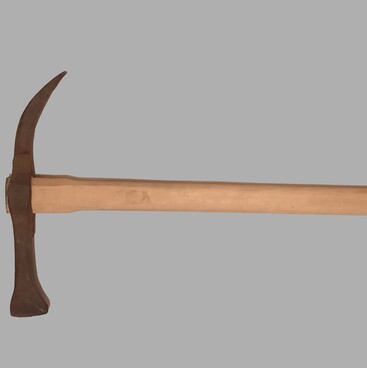To this day, drilling remains the only efficient method of hydrocarbon exploration and increasing the volumes of recovered oil and gas. For this reason, drilling rigs remain the key piece of machinery used in the oil and gas industry. One of the pivotal elements of any drilling rig is its chiseling tool, the drill bit. The drill bit is what breaks through the rock, and since there is a wide range of different drilling techniques, there are also just as many types of drill bits.
This is a tricone drill bit; bits like these are most commonly used for boring wells. They account for almost 85 percent of yearly drilling advance worldwide. This tool operates by a chipping and crushing action. The design of the bit allows its three cone-shaped rollers, which in the case of the bit from the museum collection can be recognized by their red color, to perfectly fit the cylindrical shape of the well. This also allows for the optimal centering and stability of the drill bit.
Tricone drill bits can be sectional or bodiless. A sectional tricone bit consists of several sections that are welded together along the outer seam between the mating surfaces. When this happens, the upper segments of the sections are formed into a connector end, which is then threaded with a taper male thread. The middle part of the bit is also combined into a single unit when the lugs, whose ends hold the rollers, are welded together. The outer side of the lugs is fitted with nozzles, pin shoulders, and nozzle bosses, as well as the circular semicylindrical jet nozzles.
In Russia, nozzles are usually made of cermet materials and are secured with a retaining pin (or a retaining ring, in the case of the drill bit from the museum collection). The gap between the jet nozzle and the inner wall of the nozzle hole is sealed with rubber. In most cases, in order to achieve additional protection, the shirttails of the lugs are covered with anti-abrasive hardfacing near the butt end and the backside of the roller, which is often referred to as the gage relief. Additionally, anti-abrasive hardfacing is also welded on the backside of the rollers, divided by one of the conical surfaces of the roller and providing it with gage suppression.
This is a tricone drill bit; bits like these are most commonly used for boring wells. They account for almost 85 percent of yearly drilling advance worldwide. This tool operates by a chipping and crushing action. The design of the bit allows its three cone-shaped rollers, which in the case of the bit from the museum collection can be recognized by their red color, to perfectly fit the cylindrical shape of the well. This also allows for the optimal centering and stability of the drill bit.
Tricone drill bits can be sectional or bodiless. A sectional tricone bit consists of several sections that are welded together along the outer seam between the mating surfaces. When this happens, the upper segments of the sections are formed into a connector end, which is then threaded with a taper male thread. The middle part of the bit is also combined into a single unit when the lugs, whose ends hold the rollers, are welded together. The outer side of the lugs is fitted with nozzles, pin shoulders, and nozzle bosses, as well as the circular semicylindrical jet nozzles.
In Russia, nozzles are usually made of cermet materials and are secured with a retaining pin (or a retaining ring, in the case of the drill bit from the museum collection). The gap between the jet nozzle and the inner wall of the nozzle hole is sealed with rubber. In most cases, in order to achieve additional protection, the shirttails of the lugs are covered with anti-abrasive hardfacing near the butt end and the backside of the roller, which is often referred to as the gage relief. Additionally, anti-abrasive hardfacing is also welded on the backside of the rollers, divided by one of the conical surfaces of the roller and providing it with gage suppression.



